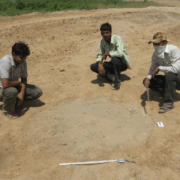Earliest evidence of cremation in Hindu,
‘Earliest evidence of Cremation’ in Hindu culture
Indian Archaeologists are casually explaining some structures as ‘Pit dwelling’. Any decent human being will not like to live in a pit, so this interpretation should be carefully analysed.
Farmana Khas, or Daksh Khera, is an archaeological site in the Meham block of Rohtak district in the northern Indian state of Haryana, spread over 18.5 hectares. It is located near the village of Farmana Khas, about 15 kilometres from the Rohtak-Hissar highway and 60 kilometres from Delhi. It is significant mainly for its burial site, with 70 burials of the Mature Harappan period (2500–2000 BC) and relatively recent addition (excavation started during 2006) to Indus Valley Civilisation sites excavated in India. (1)
I see for the first time the word ‘Necropolis’ used for an archaeological excavation site of the Indus valley civilisation. The below-given report of the Indian archaeological society contains the article; unfortunately, the report is not available anywhere on the net. (2)
Vasant Shinde, Toshiki Osada, Akinori Uesugi (eds.), Harappan Necropolis at Farmana in the Ghaggar Basin, Special Report No. 4 of the Indian Archaeological Society (2009)
This report confirms my doubt that all these Indus excavation sites are burial grounds. In this report, the authors have stated that at least part of the excavated site is a ‘Necropolis’.
Figure 1: Location map of Farmana, Picture courtesy (3)
Narender Parmar (3) reports that In Farmana-II, Haryana, he has uncovered ‘pit dwelling’ evidence. Closure scrutiny of the photo shows that it is not the case of a ‘pit dwelling’.
Figure 2: Pit-I showing the diameter is hardly 5 feet.
Picture courtesy (3)
See the above-given figure -2; the circle is hardly 5 feet in diameter; nobody could have lived in such a small pit dwelling. Narender reports that a layer of ash, charcoal and bones was found in this pit. There is a possibility that it was a sacrificial pit, where one thigh of an animal (Leg piece of sacrificed Bull) would be burnt as a burnt offering to gods. The remains of the bone could be that of sacrificed animal (Bull) bone. Otherwise, the second possibility is that it could be a funeral pyre, and the bones could be burnt remains of a cremated dead body. Proper analysis and verification of the bone will yield a good result.
The picture shows some circular discolouration, not clear-cut evidence of ‘Pit-Dwelling’. In the case of the sacrificial fire, it could be for customary ceremonies and related funeral ceremonies. Since this fire circle has been found on a burial mound, It should be assumed that it was a sacrificial fire for a funeral ceremony. In such a case of sacrificial fire, there is no need for 5 feet diameter circle of fire. Only burning a dead body requires 5 feet diameter fire circle. My conclusion is that it is the remnant of a funeral pyre. It is the earliest known recorded evidence of cremation in Hindu culture.
1. wikipedia(Farmana). Farmana. Wikipedia. [Online] 2015. http://en.wikipedia.org/wiki/Farmana.
2. Shinde(2Farmana), Vasant. Harappan Necropolis at Farmana in the Ghaggar Basi, Special report No.4 of the Indian Archaeological society. 2009.
3. Parmar(Farmana), Narender. Recent_Discovery_of_the_Pit_Dwelling_complxes_from Farmana. https://www.academia.edu. [Online] january 2015. https://www.academia.edu/8373036/Recent_Discovery_of_the_Pit_Dwelling_complxes_from_Farmana-II_District_Rohtak_Haryana._Itihas_Darpan_18_2_213-222.

